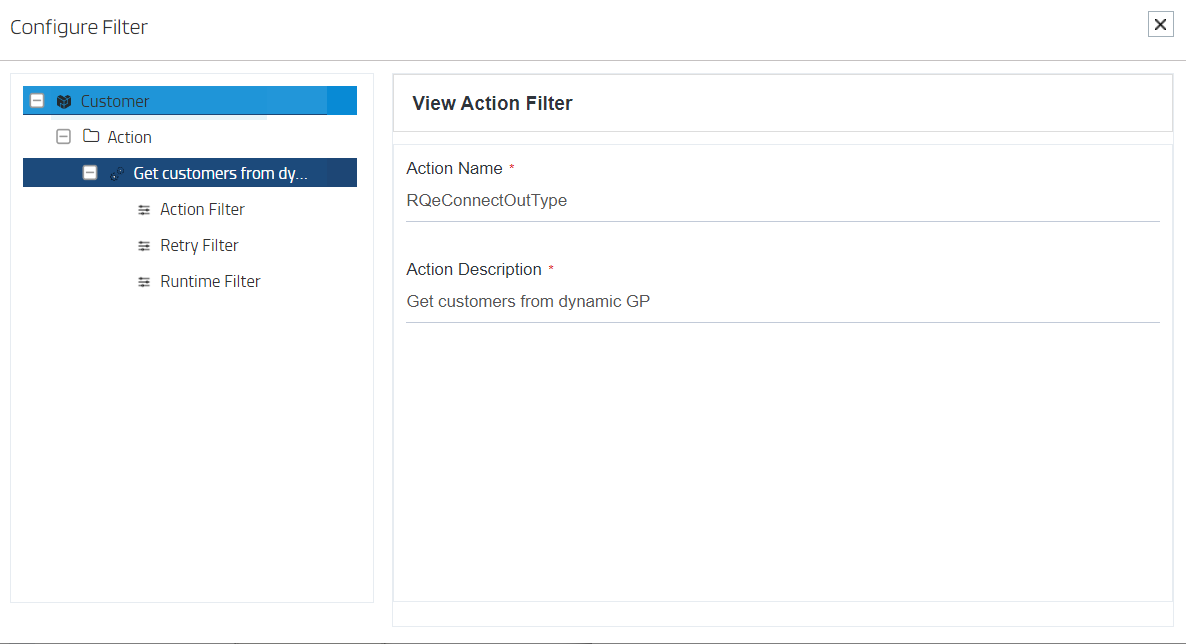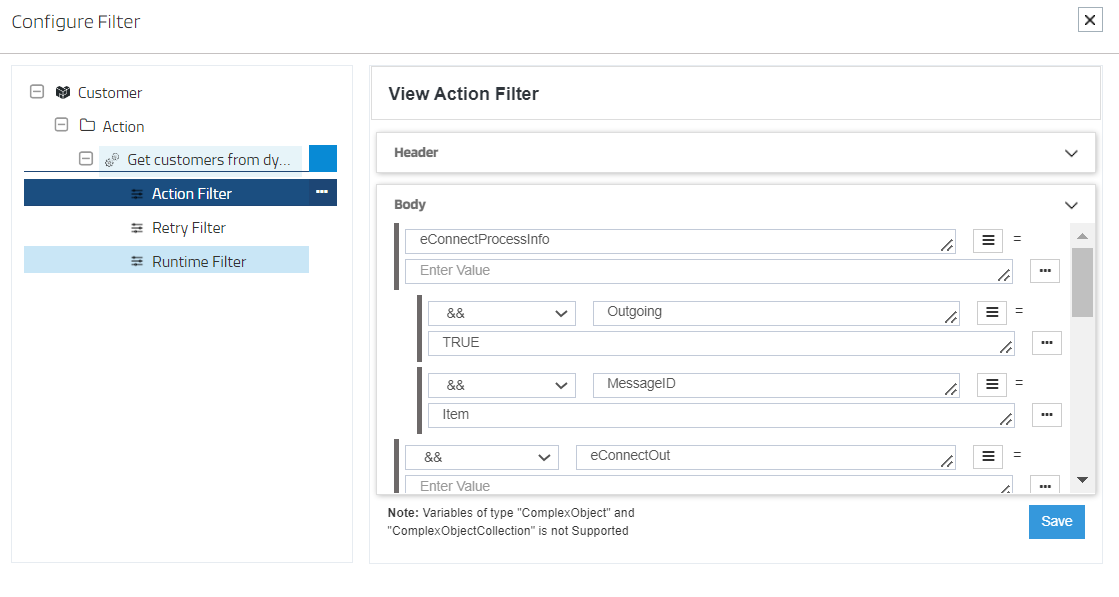Dynamic GP
Updated:
Application configuration is an integral activity prior to the process of integration. If your chosen application is Dynamic GP, credentials need to be provided for validating the agent. Here you will find the detailed description on how to configure the agents for the application Dynamic GP, Troubleshooting issues, action and its filters.
Dynamics GP is a business management solution for small and mid-sized organizations that automates and streamlines business processes and helps you manage your business. Microsoft Dynamics GP has applications for financial management, human resources management, manufacturing planning, supply chain management, field service, business intelligence, collaboration, compliance, and IT management. This section provides you the detailed process of validating the credential of the application Dynamic GP.
Note : This document is for configuring Dynamic GP in On-Premise Agent only.
Pre-requisites for Dynamic GP Configuration
- Dynamic GP should be installed in your server with all admin previlages. Dynamic GP and SQL Server may or may not be hosted in the same server.
- The server should be available where Dynamic GP is installed along with the
Company Name,User IDandPasswordto access the same. - You need to know the Authentication and APIs of the application.
-
Server Name,Database Name,CustomerNo,SQL Server UserIdandSQL Server Passwordshould be available. -
eConnect Serviceshould be available for the server and all user permission should be provided for the server whereDynamics GPis installed.
On-Premise Agent Configuration
Installation of On-Premise Agent
You need to install the agent on your local server. To Know about On-Premise Agent Configuration, Click here.
Configure the Dynamic GP Application in the Agent
- Create a processflow with Dynamic GP as source or destination application, and deploy the processflow in On-Premise agent.
- Open the agent and click the checkbox in Settings Panel.
- Move into the App Configurational Panel of the agent and configure the details of the respective application.
Steps to Configure the credentials in the Agent
1) Open APPSeCONNECT Agent by providing correct credentials.
2) In the Apps Configurational panel of the agent, you will be able to view the Dynamic GP application. Click on the + icon to add the credential.
3) Provide the credentials for Server Name, Database Name and CustomerNo.
SQL Server UserId and SQL Server Password are optional ones, if available you can provide them.
Server Name and Database Name will be provided to you by your client at the being of the configuration process.
You can find a valid CustomerNo following either of the below procedures.
-
Open
SQL Serverwith correct login credentials that have been provided to you. In the left panel underObject Explorer, expandDatabasesnode and find out the database that you are looking for. Click onNew Queryin the toolbar. To find a valid CustomerNo you need to write the queryselect * FROM RM00101and execute it. The query will return you a list of customers that are present in DynamiC GP. Select anyCustomerNofromCUSTNMBRcolumn and put it in the agent. -
Open
Dynamics GPwith validCompany Name,UserIdandPassword. From the dashboard navigate toSales -> Cards -> Customer. As the Customer Maintenance dialog box opens up, click on the lookup icon beside the Customer Id text box. TheCustomers and Prospectsopens up, showing you all the customers that are currently available in the application along with the Customer Id. Click on anyCustomer Idand the details will be available. You can select any customer Id from here.
4) After providing all the credentials. Click “Save” button. A message “Connection Data Saved” will appear if all the credentials provided by you for Dynamic GP is valid.
5) Click on the “Validate” button, to validate the connection. A message “Test Connection Successful” will appear if all the credentials provided by you for Dynamic GP is valid. In this way, you can configure the credentials of Dynamic GP.
Troubleshooting
Issue 1 : Agent Validation Failed due to improper Server Name and Database Name.
Agent validation fails due to improper Server Name and Database Name. You need to check that the
Server Name where Dynamics GP is installed is provided correctly in the OP agent. In order to check
the Database Name, open SQL Server with correct login credentials. While SQL Server opens up,
you will be able to see the database name in the left panel, check it whether it is matching exactly with
the database name provided in the OP agent.
Issue 2 : Agent Validation Failed due to improper CustomerNo.
Sometimes agent validation fails due to improper CustomerNo provided in the agent. You should provide a
valid CustomerNo which is already present in the database. Since APPSeCONNECT communicate with Dynamics GP
using a eConnect Service, thus while validating the configuration provided in the OP agent, APPSeCONNECT
sends a eConnect service request along with the CustomerNo to the application. If the specified CustomerNo is available,
the application sends a response to the agent else the validation fails and you need to find a valid
CustomerNo following either of the below procedures.
-
Open
SQL Serverwith correct login credentials that have been provided to you. In the left panel under theObject Explorer, expandDatabasesnode and find out if the database that you are looking for is availbale or not. If so, then click onNew Queryin the toolbar. SinceDynamic GPstores all customer related records inRM00101table, so to find a valid CustomerNo you need to write the queryselect * FROM RM00101and execute it. The query will return you a list of customers that are present in DynamiC GP. Select anyCustomerNofromCUSTNMBRcolumn and put it in the agent. -
Open
Dynamics GPwith validCompany Name,UserIdandPassword. From the dashboard navigate toSales -> Cards -> Customer. As the Customer Maintenance dialog box opens up, click on the lookup icon beside the Customer Id text box. TheCustomers and Prospectsopens up, showing you all the customers that are currently available in the application along with the Customer Id. Click on anyCustomer Idand the details will be available.
Issue 3 : Sometimes validation fails due to improper working of eConnect service. To check the same, you need a tool
XmlDocumentSender. Open XmlDocumentSender, a eConnect Document Sending Utility dialog box appears, configure the following.
- Click on
Connection String, provide the server name and database name in the dialog dox that appears up. - Click on
Select XML file, from the dialog box that appears select the xml file that allows customers to read by id. The xml structure to fetch a specific customer will appear underXML Document. Inside the xml structure, the nodeINDEX1TOandINDEX1FROMwill let you specify the customer id that you want to fetch. Click onSend XML. The response will be displayed in theReturn Information. According to the respone, you can identify the issue and take necessary action against it.
Actions and its Filter Implementation
While defining a connection to an API in Dynamics GP, you require clear understanding about the
data requirements and endpoint configurations. To define the endpoint in APPSeCONNECT, you need Schemas and Actions.
Actions are specifically targeted for an endpoint while schema is the data needed to execute the API.
Here, you can use RQeConnectOutType as action if you are using eConnect service to send
the request to respective application or several others approaches are also there to perform the same.

Data is fetched from source application using APIs, and as you are aware of, API provides filters
which will allow you to specify a subset of data from the whole bunch of data created in the server,
the same can be specified through Actions and Action filters. The Action filters defines the search criteria
of the data. You can add these parameters in the action filter to define the search criteria.
Suppose you need to fetch 10 customers from dynamic GP at a time. In this situation, you need to create a schema named as
Customer and action as RQeConnectOutType. Under this action, you should mention the filtering conditions
as key value pairs.

You need to mention eConnectProcessInfo and eConnectOut in the body as the filter respectively.
Under eConnectProcessInfo, use the following as child conditions
| Key | Value |
|---|---|
| Outgoing | TRUE |
| MessageID | Customer |
Under eConnectOut, use the following as child conditions
| Key | Value |
|---|---|
| DOCTYPE | Customer |
| OUTPUTTYPE | 2 |
| FORLOAD | 0 |
| FORLIST | 1 |
| ACTION | 0 |
| ROWCOUNT | 10 |
| REMOVE | 0 |
| WhereClause | CREATDDT BETWEEN ‘~{CreatedDate}~’ and ‘~{MaxDateLimit}~’ |
Note : Similarly, for other APIs Product, Orders, Shipment etc. you should follow
the above mentioned action filters and procedures to design, deploy and execute processflow such
that the data could be synced properly.


